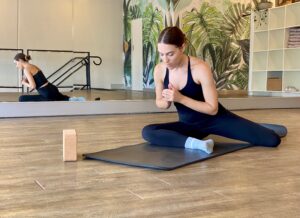Why is mobility training important?
March 21stMobility training has become a hype in the fitness and recovery world, but what does it actually mean? More than just stretching, mobility training enhances movement quality, prevents injury, and helps you move more freely in daily life and sports.
What is mobility training?
At its core, mobility is the ability to move freely and easily. More specifically, it refers to how well a joint moves through its full range of motion with control.
Is mobility training important?
Many people experience limitations in movement and exercise due to various factors. In simple terms, this often happens when they attempt movements that their body hasn’t yet developed the capacity for. This could be due to a lack of strength needed to maintain a position or an insufficient range of motion to access that position in the first place. Since everybody is different, the reasons behind these limitations can vary from person to person.
In any type of training, adaptation is a fundamental concept, we apply a specific input or demand to the body (e.g., lifting a weight) to achieve a desired outcome (such as increased strength). Mobility training follows the same principle, but the input differs, focusing on controlled movement, range of motion, and joint stability rather than large amounts of external load.
For example, someone might be highly flexible and able to rotate their hips easily, but they may struggle to control these positions actively, especially when working against gravity in a standing position.
In this case, mobility training would focus on building strength and control in those end-range positions. This could involve small contractions or targeted strengthening exercises to gradually develop the ability to stabilise and use their full range of motion effectively. On the other end of the spectrum, someone can be strong but lack flexibility, making it difficult to reach deep stretches, such as the splits. Their mobility limitations often stem from the inability of the surrounding soft tissues to lengthen effectively. In this case, their mobility training would start with dynamic stretching in a controlled range, gradually progressing to more passive stretching. This approach allows their body to adapt safely, building tissue tolerance and reinforcing that these new ranges are stable and accessible.
As a coach, I view mobility as a broad concept, it can take the form of a strengthening exercise or a stretching exercise, depending on the goal of the movement. Traditionally, we’ve categorised exercises into fixed groups, but in reality, movement is fluid, and exercises can be adapted in countless ways to suit the needs of an individual.

Since mobility training is a complex and multifaceted topic, it’s impossible to cover everything in a single blog. However, here are some key points to consider when incorporating mobility work into your routine:
1. How often should you do mobility training?
The key to improving mobility isn’t volume, it’s consistency over time. Regular movement signals to the body that certain ranges of motion are safe, helping to improve flexibility, strength, and joint health gradually.
For those just starting out, I recommend choosing three simple mobility drills or exercises that feel good for your body or are tailored to your needs. Aim to do them daily. This takes less than five minutes and can easily fit into your routine: First thing in the morning, as a warm-up before a workout, or as part of a cool-down or bedtime routine.
As you become more familiar with mobility work, integrating it into your daily habits becomes second nature. Many people find that, over time, they begin to intuitively recognise when their body needs certain movements.
Example: You could incorporate two dynamic stretches into your warm-up and finish with one targeted mobility drill after your workout, when your body is already warm and primed for deeper movement.
2. Does flexibility mean mobility?
Many people say, “I’m just not naturally flexible,” assuming that their mobility is predetermined by genetics. While it’s true that some individuals are naturally more stiff or flexible, this doesn’t mean mobility can’t be improved.
Genetics may influence how quickly someone responds to mobility training, but the human body is highly adaptable, often far more than we give it credit for. Many times, I’ve worked with people who believed they “could never do that”, only to realise they simply hadn’t trained their body in the right way.
For example, you wouldn’t expect to be able to do the splits if you’ve never actively worked on achieving that range of motion. Mobility, like strength, requires consistent and intentional training to develop.
3. Don’t be hard on yourself!
Because mobility training requires consistency, it’s easy to feel frustrated or discouraged. Many people I’ve coached say that mobility work feels challenging and uncomfortable, and honestly, that’s the point. If we want our bodies to move in ways they haven’t before, we need to gradually expose them to new demands so they can adapt.
While setting mobility goals is great, the key is to enjoy the process rather than focusing solely on the outcome. Results come with active effort, and that’s all it takes.
We all start somewhere, and everyone has sticky spots that require extra attention. Be patient, be kind to yourself, and take it at your own pace. Small, consistent efforts will lead to long-term improvements.
4. How to get started with mobility training
Everybody moves differently, and the goals people have for mobility training can be very different. Some might want to improve general movement quality, while others are working toward specific performance outcomes or rehabilitation.
There are countless mobility programs available on social media, and while they can be a good starting point, it’s important to remember that what works for one person may not work for you. A follow-along video might be useful if your goal is simply to maintain general mobility and keep your body feeling good. However, if you are aiming for a specific skill, movement capacity, or rehab goal, seeking personalised advice could be a more efficient and effective way to reach your target.
A well-structured mobility plan should be tailored to your body’s needs, ensuring that the time and effort you put in translates to real improvements in movement quality and function.
5. Breathe!
Slow and controlled movements are generally the most effective when working on mobility. Being mindful of how your body moves helps strengthen the body-brain connection, allowing for smoother and more efficient movement patterns.
One of the hardest concepts to grasp is that your nervous system plays a key role in mobility. The body naturally protects itself from perceived threats, which is why you might struggle to reach end ranges of motion if you haven’t yet built the capacity to be there safely. Forcing your way into a stretch won’t necessarily improve mobility. In fact, it often has the opposite effect. If you find yourself tensing up while holding a stretch, your body isn’t truly relaxing into the position, meaning you’re unlikely to see much progress.
Instead of pushing through discomfort, ease into movements gradually, focus on steady breathing, and listen to your body’s response. Creating a sense of safety and control within your range of motion will lead to more effective and long-lasting improvements.
If you have specific movement goals but feel unsure about where to start, reach out. Mobility training can feel overwhelming at times, but with the right guidance, you can create a plan that aligns with your body’s needs and long-term goals.
By Marla Laverie
Senior Remedial Massage Therapist
Marla is a Senior Remedial Massage practitioner, mobility-certified trainer, and an experienced yoga and Pilates instructor. She is also a qualified strength and conditioning coach, bringing a well-rounded approach to movement, recovery, and performance.
If you would like an appointment with Marla, book here.
For more movement inspiration, check out@kinematicsperformanceor connect with Marla on Instagram @marlamovementwellness.
